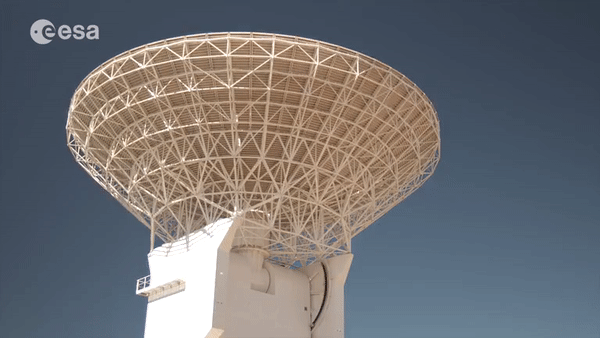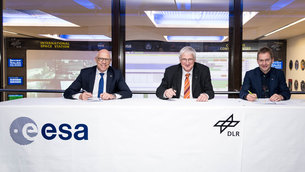3.04.2019

ESA AND DLR IN JOINT STUDY TO SUPPORT DEEP SPACE MISSIONS
An existing deep-space dish antenna at the DLR Weilheim site, near Munich, may offer an almost-readymade solution to the problem of providing sufficient ground station capacity to support ESA’s current and future deep-space exploration missions. Now and in the next few years, ESA is sending some of the most advanced spacecraft ever flown to exotic locations like Mars, Mercury and Jupiter, and these missions all have one thing in common: they need plenty of ground station capacity to download their masses of science data and to enable mission controllers to send up commands.
ESA's tracking station network – Estrack
ESA already has three state-of-the-art ground tracking stations – identifiable by their big
35 m-diameter dish antennas – located in Australia, Spain and Argentina. These countries are located at longitudes about 120 degrees apart, so that the three stations can provide global coverage for missions voyaging in virtually any direction in our Solar System.
“The stations were built between 2002 and 2012, and their capacity in transmitting and receiving data will soon be reached, given the ambitious missions like BepiColombo, ExoMars and Juice now being implemented – and the fact that these newer spacecraft can all download tremendous amounts of science data,” says Pier Bargellini, responsible for the operation of ESA’s ground facilities.
DLR 30 m dish antenna supported ESA missions in the past
With an eye to solving the challenge, engineers at ESA and The German Aerospace Center (DLR) have begun assessing the possibility of using an existing 30 m-diameter dish antenna at Weilheim, 60 kilometres south-west of Munich, to provide some add-on tracking capacity at the European longitude.
This could solve part of the capacity problem on this continent while at the same time reusing existing European infrastructure and reducing the need for costly new construction.
DLR Weilheim features a number of dish antennas with varying sizes and the site is operated 24 hours/day to support near-Earth missions such as TerraSAR-X, TanDEM-X and GRACE Follow On controlled from DLR’s German Space Operations Centre at Oberpfaffenhofen. The smaller antennas are also used to support ESA missions orbiting Earth, like Integral.
The 30 m dish antenna supported ESA missions in the past, and is presently used when DLR supports partner agencies, such as downloading data from the Hayabusa 2 mission flown by Japan. It has also recently been used to receive signals from global navigation satellites like GPS and Galileo.
A series of initial tests conducted by DLR and ESA engineers in the past few months proved that the dish and its sophisticated radio equipment could receive signals from current ESA missions, including Gaia and Mars Express.
Engineers from DLR and ESA will continue testing the Weilheim antenna
“Since the 30 m antenna was designed for solar and deep space missions, we are happy to see ESA’s interest in bringing it back to its original purpose,” says Rolf Kozlowski, head of the DLR Communications and Ground Stations department.
“To integrate the antenna into the ESA network would be a challenging but rewarding task for DLR.”
“In addition to the reception functionality, the antenna could be upgraded to add transmission capabilities. Its overall characteristics makes it ideal to support missions at lunar distances or even missions to the Lagrange points.”
In addition to supporting future ESA and European missions, upgrading the dish would also enable DLR to expand its use for their own future missions or for those of partner agencies. Such cross-support arrangements are common in the field of spacecraft operations, and are typically done on an hour-for-hour exchange basis or in exchange for sharing a mission’s scientific data. Engineers from the two agencies will continue testing the Weilheim antenna, with the aim of proving its ability to begin serving as a functional communications backup for ESA missions like Gaia and Mars Express.
Joint study to support deep space missions
Joint activities between ESA and national space agencies in the area of communications are excellent examples of how Europe can become even more capable and stronger by developing a ‘network of operational centres’. By linking the efforts of control centres operated by ESA and agencies like DLR, and their ground stations, resources can be shared – and European missions, industry and space ventures can benefit overall, making Europe even more competitive and attractive for international partnership in space.
“Upgrading the Weilheim antenna to full deep-space capability is a good idea that promises to support not only ESA but also DLR itself, partner agencies and new commercial space actors,” says Rolf Densing, ESA’s Director of Operations. “And it will provide an excellent return on investment for European taxpayers.”
How we make a space mission
ESA is Europe’s space agency, enabling its 22 Member States to achieve results that no individual nation can match. ESA combines space mission development with supporting labs, test and operational facilities plus in-house experts covering every aspect of space, supported through the Agency’s Basic Activities.
Quelle: ESA




